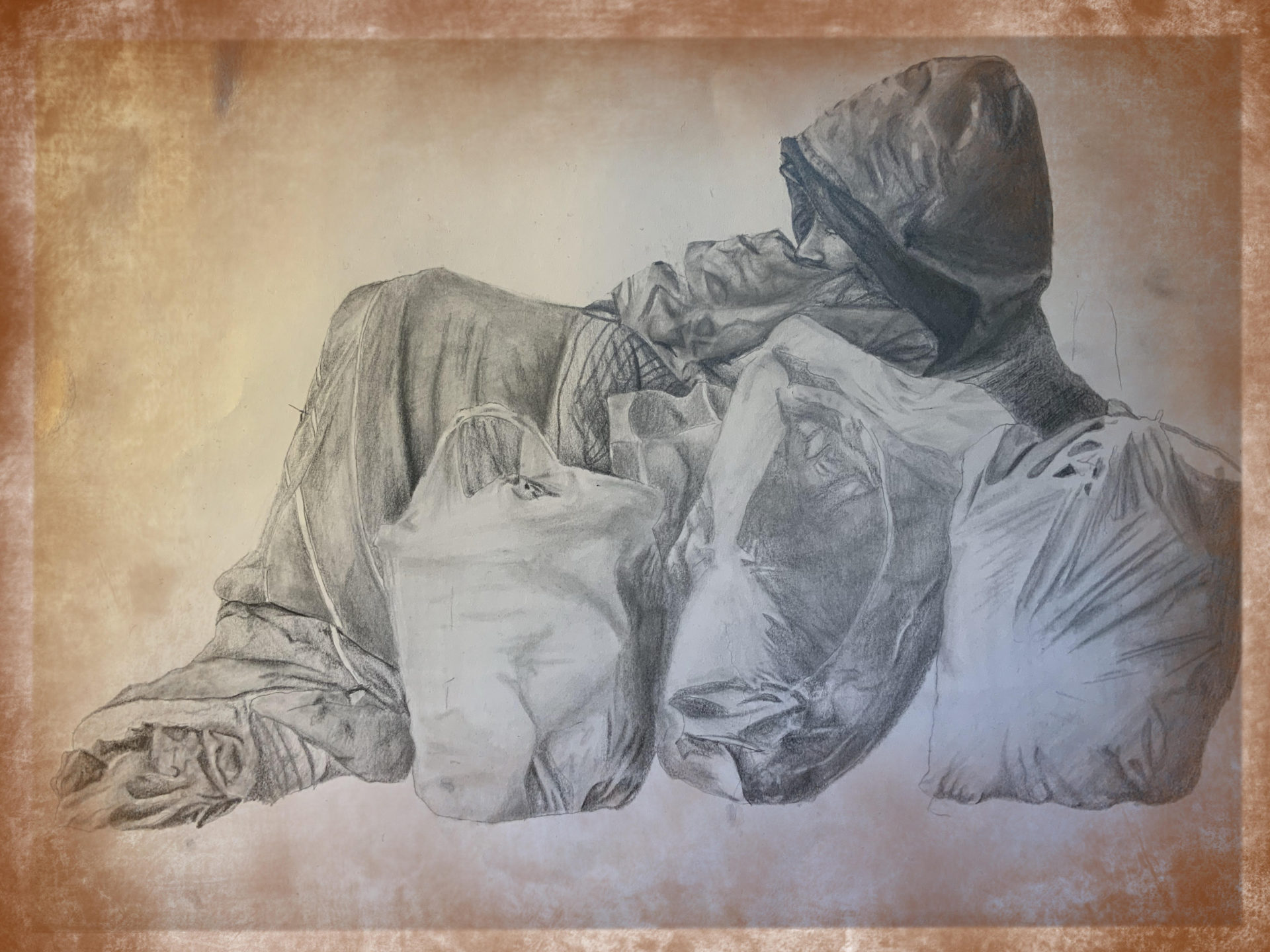Homelessness – an inside view
My creative piece is based on a group discussion with a staff member at a GP surgery. We listened to the inspiring story of his experience with homelessness, addiction and struggles with the NHS. He had spent the majority of his years homeless and used heroin for most of his adult life (on and off, depending on whether or not he was in a rehabilitation programme at the time).
I initially chose to draw this piece in pencil because it is the medium that I feel most comfortable using, but while drawing the piece I found the monotone, black and white nature of the medium lent to the feeling of hopelessness in the story he told us. The brown overlay was done using an iPad. I chose to add this to reflect a particularly striking part of the story he told us – that he felt he was seen as dirty when he went to hospital. He mentioned he was sure that if he wore different clothes or had straighter teeth the staff would treat him with more respect and give him the treatment that he needed. Instead, most times he went to the hospital, he was given drugs and felt like he was hurried out – as if the staff did not want him there. The purpose of this piece is to acknowledge the biases we have about people who are homeless in the hopes that we can challenge them and especially as healthcare professionals, give much needed respect and time to all our patients.
The interview was very emotional for me as a first-year medical student who grew up in privileged surroundings as I had rarely encountered homelessness or drug addiction, and when I had, I did not give it much thought. Being able to talk about these issues in a safe environment with a person who was so articulate about his experience and emotions was powerful and eye-opening. He talked about his relationship with his family, his past trauma and the precarious journey towards mental health. Speaking about living on the streets, he invited us to consider the times that we have walked past a homeless person in a doorway and not given it a thought. Hearing about his past and the way he dealt with it humanised him and other people who are homeless more than I realised possible – and made me realise that any person could be that homeless person on the street that most people ignore. I drew an image where the face was indiscernible to show this, and that what most people initially see when they pass a person who is homeless on the street is that they are homeless – not that they are people (or at least that is how the people who are homeless feel that people look at them). In the discussion, this member of staff also spoke about going to the GP and having an appointment with someone who made him feel safe and listened to, and how this sparked his recovery.
Effective Consulting, Year One, 2021

I like this piece because it reflects on how healthcare, a basic human right, is still not perfect and available to all. It addresses the inequity and inequality of healthcare caused by the unconscious biases within the system. Coming from India where one’s financial circumstances usually determines the quality of the medical treatment that one receives, this piece is very relevant to what I have seen. It reminds me of the disparities in healthcare and the privilege I have to have not had to experience that kind of struggle. The artist’s use of colour and realism encapsulates the isolation felt by the GP staff member, and those that are impoverished, so vividly that it forces the audience to put themselves in their shoes. I think that the empathy that this piece fosters within the audience, including myself, is important because it encourages them to be more aware of those that are less privileged and urges them to make a more conscious effort to treat them with the same dignity as anyone else. In terms of healthcare, this mindset strengthens the pillar of justice and pushes healthcare to truly become a basic human right rather than a rare commodity reserved for the rich.
I felt drawn to this piece as I think it shows a very thought provoking depiction about how people without homes are often dehumanised or forgotten. This includes both when people walk past on the streets and also in a healthcare setting where biases or lack of understanding could prevent the best standards of care. The blurred brown overlay as a barrier between the individual and others helps show the isolation that accompanies homelessness and helps depict the patient’s experience of not being listened to and feeling judgement from those who were supposed to provide support. This is further emphasised by the lack of background surrounding the figure as it makes them appear alone and unsupported.
I found the artist’s decision to make the face ambiguous really powerful as it encourages the viewer to imagine themselves in a similar situation and helps to break through some of the stigma and preconceived ideas that are present in society regarding homelessness.